Dates 12 Oct 1944 – 16 Oct 1944 Location Philippine Sea | Result American victory | |
 | ||
Similar Pacific War, World War II, Raid on Taihoku, Battle of the Visayas, Battle of Mindoro | ||
The Formosa Air Battle (Japanese: 台湾沖航空戦, Chinese: 臺灣空戰) took place between October 10 and 20, 1944, off the eastern coasts of the Ryukyu Islands, Formosa, and Luzon. It was fought by the Imperial Japanese Navy Air Service and the approaching Task Force 38 of the United States Third Fleet and was one of a series of air raids on Japan during the Pacific War. The attacks served to prevent Japanese aircraft from participating in the Battle of Leyte Gulf later that month.
Contents
The battle was a major victory for the US Navy, with its superior pilot training and aircraft proving decisive. Japanese air power in the region was exhausted after the engagement, giving the Americans air superiority and weakening Japan's ability to defend the Okinawa Islands in the upcoming Okinawa Campaign. However, in an effort to boost morale and to cover up the defeat, Japanese headquarters claimed to have sunk 45 Allied ships, including 11 aircraft carriers and four battleships
Background
The attacks on Formosa and the Ryukyu Islands were carried out to prevent Japanese aerial forces there from participating in the planned landings at Leyte. The Japanese had contingency plans prepared for a number of eventualities, including one in response to attacks on Formosa—Shō-Gō 2.
Battle
The U.S. Third Fleet started carrier-launched raids against Formosa on October 12, 1944. The Japanese response was to send waves of aircraft against the U.S. carriers. On October 13, the cruiser USS Canberra was seriously damaged by a torpedo bomber. For one of the first times in the war a kamikaze aircraft was used, which lightly damaged the carrier USS Franklin. By the following day the aerial forces based on the island were all but neutralized. In the fighting, the light cruiser USS Houston was damaged by an enemy torpedo, while the carrier USS Hancock, the light cruiser USS Reno and two destroyers all incurred some form of damage. Over three days the Japanese lost approximately 500 aircraft and many ships, almost their entire air strength in the area. American losses in aircraft amounted to 89.
